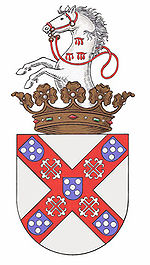Duke of Cadaval

Duke of Cadaval (Duque de Cadaval) is a title that is carried out in a younger, illegitimate and not entitled to the throne line of the Portuguese royal family Braganza .
history
Álvaro de Bragança, Lord of Cadaval , was a younger brother of Ferdinand II, 3rd Duke of Braganza , both grandsons of Alfons of Braganza , an illegitimate son of King John I of Portugal who had been excluded from the throne through his relationship with Inês Pires . Alfons had married Beatrice Pereira, the heir to the Konnetable Nuno Álvares Pereira , the richest nobleman in Portugal after the king. Alvaro married Filippa de Melo-Villena, mistress of Ferreira, in 1479, their descendants took the family name Melo, later the family name Alvares Pereira de Melo.
The title of Duke was given by King John IV of Portugal in 1648 to Nuno II. Álvares Pereira de Melo (1638-1727), the son of Francisco II. De Melo, 3rd Marques de Ferreira and 4th Count of Tentúgal, with the proviso that the respective heir of the duke should bear the title of margrave and the heir of the margrave the title of count.
The title Duke of Cadaval is a title de juro e herdade , d. H. hereditary and freely transferable, in which the king cannot intervene in the succession - except in cases of treason and lese majesty. From 1835 onwards, there was also the obligation to pay an enormous fee for registering the transfer of title.
List of the Dukes of Cadaval
Regular dukes
- D. Nuno Álvares Pereira de Melo (November 4, 1638 - January 27, 1727), 1st Duke of Cadaval, 4th Marques de Ferreira, 5th Conde Tentugal, ∞ I Henriette of Lorraine, ∞ II Margaret of Lorraine. From second marriage:
- D. Luís Ambrósio Álvares Pereira de Melo (December 7, 1679 - November 13, 1700), 2nd Duke of Cadaval.
- D. Jaime Álvares Pereira de Melo (September 1, 1684 - May 29, 1749), 3rd Duke of Cadaval, 5th Marques de Ferreira, 6th Conde de Tentugal.
- D. Nuno Caetano Álvares Pereira de Melo (November 17, 1741 - September 17, 1771), 4th Duke of Cadaval, 6th Marques de Ferreira, 7th Conde de Tentugal.
- D. Miguel Caetano Álvares Pereira de Melo (February 6, 1765 - March 14, 1808), 5th Duke of Cadaval, 7th Marques de Ferreira, 8th Conde de Tentugal.
- D. Nuno Caetano Álvares Pereira de Melo (April 7, 1799 - February 14, 1837), 6th Duke of Cadaval, 8th Marques de Ferreira, 9th Comte de Tentugal, ∞ D. Maria Domingas Francisca de Bragança de Sousa e Ligne .
- D. Jaime Caetano Álvares Pereira de Melo (February 6, 1805 - September 1878), 7th Duke of Cadaval, 10th Marques de Ferreira, 11th Conde de Tentugal.
- D. Jaime Segismundo Álvares Pereira de Melo (December 22, 1844 - June 26, 1913), 8th Duke of Cadaval, 11th Marques de Ferreira, 12th Conde de Tentugal.
- D. Nuno Maria-José Caetano Álvares Pereira de Melo (November 29, 1888 - February 16, 1935), 9th Duke of Cadaval, 12th Marques de Ferreira, 13th Conde de Tentugal.
Titular dukes
After 1834 the dukes of Cadaval, who had supported King Michael I , lived in exile in Paris after his overthrow until the proclamation of the republic in 1910. Despite the abolition of the monarchy and the title of nobility in Portugal, the title of duke is continued by the Álvares Pereira de Melo family.
- D. Jaime Álvares Pereira de Melo (June 27, 1913 - July 30, 2001), 10th Duke of Cadaval, 13th Marques de Ferreira, 14th Conde de Tentugal.
- D. Diana Mariana Vitória Álvares Pereira de Melo (born July 25, 1978), 11th Duchess of Cadaval, 14th Marquesa de Ferreira, 15th Condesa de Tentugal, Duchess of Anjou through her marriage (2008) to Charles Philippe d'Orléans
The title of 13th Duchess was bestowed by the Portuguese pretender Duarte de Bragança without any legal basis (in Portugal, the conferring of nobility titles has always been a right of the state and not a private right of the king (or even of pretenders)). In addition, Diana Álvares Pereira de Melo has two older sisters from her father's first civil marriage, whose rights are at least to be regarded as equal.
literature
- Marie-Nicolas Bouillet , Alexis Chassang (eds.): Duc de Cadaval . In: Dictionnaire universel d'histoire et de géographie , 1878 (see also Wikisource)
